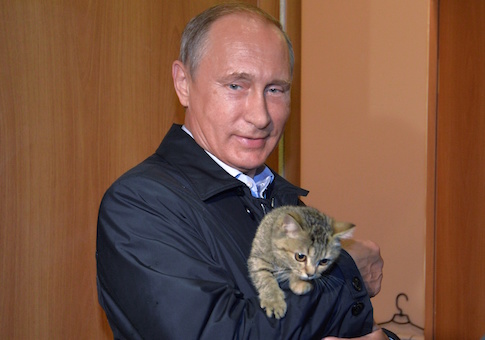Russia has deployed as many as 10,000 troops in eastern Ukraine for more than a year and has actively sought to hide the deaths of its soldiers, according to a new report that provides a comprehensive assessment of the Kremlin’s invasion of its neighbor.
The report was published Thursday by the Interpreter, a daily online journal that translates Russian media and reports on Russian affairs, also detailed the Kremlin’s provision of increasingly sophisticated weaponry and vehicles to separatists in Ukraine. Nearly 8,000 people have been killed in the Ukrainian conflict since April 2014.
The conflict originated in March 2014 when unmarked Russian soldiers seized the Crimean peninsula in Ukraine, an invasion that followed Ukraine’s ousting of a pro-Moscow leader. Despite denials from Russian President Vladimir Putin at the time that the troops belonged to Russia, he later admitted that he deployed them.
Following Russia’s annexation of Crimea, Putin escalated support to separatists in eastern Ukraine that resided in areas with a majority of ethnic Russians. Reserve officers in the Russian military, who also had ties to the Russian military intelligence agency known as the GRU, commanded the rebels in attacks. By June 2014, the Ukrainian military said that Russia had massed more than 40,000 troops on Ukraine’s border and deployed about 7,000 to 10,000 Russian soldiers inside Ukraine.
While Ukrainian forces achieved some victories early in the conflict, a profusion of Russian-supplied advanced weapons helped the separatists gain the upper hand by the summer of 2014. These included T-64 and T-72 battle tanks, shoulder-fired anti-aircraft missiles known as MANPADS, and the Strela-10 armored vehicle with surface-to-air-missiles and machine guns.
Additionally, the separatists likely used the Russian-supplied Buk, a long-range anti-aircraft missile system, to shoot down Malaysian Airlines Flight MH17 in July 2014, killing nearly 300 people. The rebels’ increased use of anti-aircraft weapons deterred the Ukrainian military from using its air power and further hampered its forces, the report said.
Satellite images and other evidence indicate that the separatists did not capture the weapons from Ukrainian forces, such as with the T-72 tank.
"Not only had the Ukrainian military never used this tank in the conflict, but multiple variants of the tank spotted in eastern Ukraine were never possessed by the Ukrainian military because they were modernized versions of a tank that Russia never exported," the report said.
A string of defeats by Ukrainian forces, including at the southeastern border and at coastal towns near the strategic port of Mariupol, forced Ukrainian President Petro Poroshenko to negotiate a ceasefire in September 2014. According to the report, "evidence suggests that Russian military units were at the vanguard of every part of the battles that were occurring. Ten Russian military paratroopers were even captured on the battlefields in the area."
After a brief cessation in fighting, the ceasefire, known as the Minsk agreement, crumbled. Russia continued to provide heavy weaponry to their proxy forces, which contributed to separatist victories at the Donetsk Airport and Debaltsevo in rebel-controlled territory.
"In November Russia supplied them with new military hardware like the 1RL232 ‘Leopard’ and the 1RL239 ‘Lynx’ ground-scan radar systems, and by January the BPM-97 armored vehicle and GAZ Vodnik armored infantry vehicle, weapons only used by the Russian military, had appeared in the hands of forces as well," the report said.
A second ceasefire agreement in February also failed to stanch the fighting. Russian forces are now prepared to invade at any time, depending on the circumstances of the war, the report said.
"The Russian military is digging in, building forward operating bases between Mariupol and Donetsk, and turning temporary staging areas on the Russian side of the border into permanent installations for invasion preparations."
Putin has instituted several measures to prevent the deaths of Russian soldiers in Ukraine from inciting a backlash at home, the report said. The troops are often young enlistees from disparate regions of Russia, and they are treated at clinics scattered across the country. Groups and news outlets that attempt to report the deaths of Russian soldiers are harassed or attacked by authorities and unknown assailants.
In May, Putin signed a measure that prohibits information about the deaths of Russian forces in peacetime, an attempt to further conceal details about Russia’s involvement in Ukraine.
The report estimates that about 600 Russian troops have died in Ukraine, while about 800 are missing.
Despite Poroshenko’s repeated requests for weapons from U.S. forces to help defeat the separatists, the Obama administration has refused to provide any substantial support. In a recent Washington Post interview, Poroshenko said Ukraine is in need of "defensive weapons."
"We don’t talk about the lethal weapons," he said. "Ukraine is an industrialized nation that can produce their own weapons. We’re talking about the defensive weapons, which help us just defensively."
"And sorry for my pathos, but we here defend not just Ukraine’s sovereignty and territorial integrity," he continued. "We here defend freedom and democracy. And we are now fighting with the weapons of the 20th century against the weapons of the 21st century."
